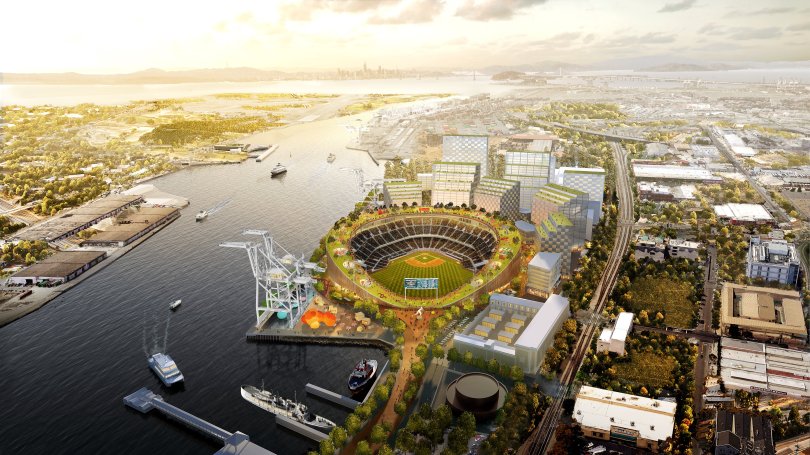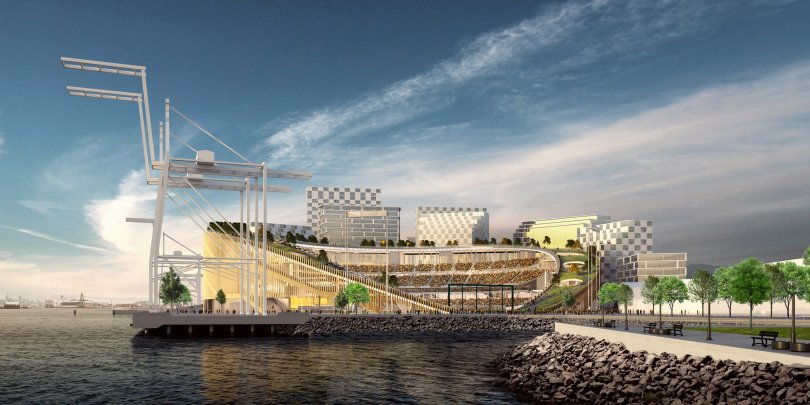We end 2019 with a countdown of the 10 biggest stories of the year on Ballpark Digest, as chosen by editors and partially based on page views. Today, #8: the Oakland A’s continue their push for a new Howard Terminal ballpark.
In November 2018, the Oakland A’s unveiled an ambitious facility plan that included the construction of a new ballpark at the waterfront Howard Terminal site. Over the course of 2019, the organization made some strides in bringing that vision to life, but it is entering 2020 with plenty of uncertainties to resolve.
The broad strokes of what the A’s first revealed back in 2018 remain largely the same: The team is expected to privately finance the construction of a new ballpark at Howard Terminal, which would be at the center of mixed-use development on the site. Additionally, the team would gain control of the sprawling, publicly owned Oakland Coliseum complex for a redevelopment initiative.
In the span of this year, the A’s managed to make some progress in bringing that plan to fruition. At Howard Terminal, the A’s received Port of Oakland approval on a tentative agreement that includes a 66-year lease that would see them pay $3.8 million annually for the first 20 years. Additionally, bills at the state level designed to help advance the project received ample support from California lawmakers and were signed by governor Gavin Newsom in October. One bill would allow Oakland to create a special taxing district to help fund any infrastructure contributions, while the other legislation that received his signature effectively streamlines the permitting process by allowing the State Lands Commission to decide if the ballpark and surrounding development is an appropriate use of the site.
Efforts to gain control of the Coliseum site also made progress. The Alameda County Board of Supervisors moved forward in April with a planned sale of its half interest in the Oakland Coliseum site to the A’s ownership for $85 million. A later lawsuit filed by the City of Oakland–which co-owns the site with the county–temporarily put the transaction in question, but the city opted last month to drop the lawsuit and open negotiations with the team. Alameda County voted this week to proceed with the sale, triggering a 190-day review period that could lead into a finalized agreement.
Those actions represent significant steps for the A’s, given that their facility plan calls for ambitious projects at two separate sites that have their own complexities. However, it will still take time for a final decision on the proposal to be made. The Howard Terminal project remains the subject of an ongoing environmental review which, when completed, will analyze the proposed development’s potential impact on the property. Additionally, the idea of a ballpark and surrounding development continues to draw opposition from a coalition of port stakeholders, who believe that the project would interfere with existing uses on the site. Locally, there will also be some crucial decisions made by the Oakland City Council, including whether to approve the creation of a special use tax district to help fund infrastructure for a Howard Terminal project. The city also remains in negotiations with the A’s about the Coliseum, which will likely involve plenty of discussion about the terms of a sale and any community benefits that eventual redevelopment of the site could yield.
There are still plenty of steps for the team to conquer before it is determined for sure if its current facility plans move forward, but the A’s are at least winding down 2019 with some progress on their proposal.
Rendering courtesy Oakland A’s and Bjarke Ingels Group.


